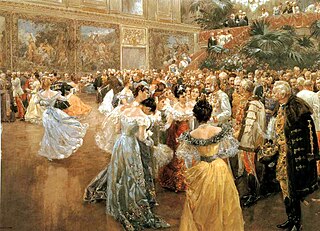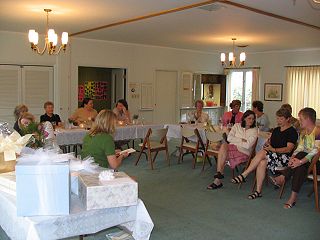
A place card is a piece of paper indicating what table a guest at an event, such as a wedding or banquet, is assigned to sit. [1] Place cards generally have the guest's name and table number, and frequently have some design as well to add style. [2]

A place card is a piece of paper indicating what table a guest at an event, such as a wedding or banquet, is assigned to sit. [1] Place cards generally have the guest's name and table number, and frequently have some design as well to add style. [2]
Place cards also serve the function of identification of those who may otherwise be unknown to one another. Once taken by the respective guests, they are placed at the assigned seat, and once there, this enables others to identify the person sitting in that seat by name. [2]
At some weddings, place cards can double as the menu for the food that is served at the wedding. [3]
Place cards are not only used for weddings and are not always pieces of paper. Theme based celebrations have become extremely popular for such party celebrations as Bar and Bat Mitzvah celebration meals, as well as birthdays, sports banquets, anniversaries, retirements, corporate events, etc. Custom place cards coordinated with the celebrant's theme have become very popular as well.
Place cards can be decorated to fit the party's theme. For example, if the theme of the wedding or party is a beach theme, the card might have a tropical flower on it. Cards can also indicate tables using token objects. Sea shells, party gifts, color of the tablecloth, plates or cups on the table may be used to identify the assigned table.
Place cards have a long history, dating back to ancient civilizations where they were used for various purposes, such as divination and game playing. The earliest known card game was played in China in the 9th century, and cards soon spread to other parts of Asia, the Middle East, and Europe.
Place cards, especially if fancy, can be an added expense for the couple. [2]
The use of place cards in some circles may be controversial. Some guests may want to sit wherever they wish. [4]

Shuffling is a procedure used to randomize a deck of playing cards to provide an element of chance in card games. Shuffling is often followed by a cut, to help ensure that the shuffler has not manipulated the outcome.

A wedding reception is a party usually held after the completion of a marriage ceremony as hospitality for those who have attended the wedding, hence the name reception: the couple receive society, in the form of family and friends, for the first time as a married couple. Hosts provide their choice of food and drink, although a wedding cake is popular.

Waiting staff (BrE), waiters / waitresses, or servers (AmE) are those who work at a restaurant, a diner, or a bar and sometimes in private homes, attending to customers by supplying them with food and drink as requested. Waiting staff follow rules and guidelines determined by the manager. Waiting staff carry out many different tasks, such as taking orders, food-running, polishing dishes and silverware, helping bus tables, entertaining patrons, restocking working stations with needed supplies, and handing out the bill.

Murder mystery games are a genre of party games. One of the players secretly plays a murderer, whilst other players must determine who among them is the criminal. Murder mystery games often involve the actual 'murders' of guests throughout the game, or open with a 'death' and have the rest of the time devoted to investigation.

Card counting is a blackjack strategy used to determine whether the player or the dealer has an advantage on the next hand.

Duplicate bridge is a variation of contract bridge where the same set of bridge deals are played by different competitors, and scoring is based on relative performance. In this way, every hand, whether strong or weak, is played in competition with others playing identical cards, and the element of skill is heightened while that of chance is reduced. This stands in contrast to Bridge played without duplication, where each hand is freshly dealt and where scores may be more affected by chance in the short run.

A wedding invitation is a letter asking the recipient to attend a wedding. It is typically written in the formal, third-person language and mailed five to eight weeks before the wedding date.

A ball is a formal dance event often characterised by a banquet followed by a social dancing. Ball dancing emerged from formal dances during the Middle Ages and carried on through different iterations throughout succeeding centuries, such as the 17th century Baroque dance and the 18th century cotillion. Several variations exists such as the masquerade and debutante ball as well as the more modern prom.

A bridal shower is a gift-giving party held for a bride-to-be in anticipation of her wedding.
A sittning is in Sweden and Finland a seated meal held within a set time frame. In restaurants it may refer to a seating, i.e. the time given for a crowd to have their meal. The term is also used to denote the part of a party that is a seated meal. Though it can refer to any kind of meal, it is often used to refer to a student sittning.

A state banquet is an official banquet hosted by the head of state in his or her official residence for another head of state, or sometimes head of government, and other guests. Usually as part of a state visit or diplomatic conference, it is held to celebrate diplomatic ties between the host and guest countries. Depending on time of the day, it may be referred to as a state dinner or state lunch. The size varies, but the numbers of diners may run into the hundreds.
Indian wedding cards are cards that are made and distributed to invite guests to the wedding ceremony and to honour and commemorate the wedding of two people. Since the medieval period, Indian wedding cards have carried great importance in the Indian subcontinent, and are known through several names such as :निमंत्रण पत्र/पत्रिका,. These invitation cards are used for announcing the marriage ceremony and this process of sending an invitation card to guests and relatives forms an integral part of the ritual. Simultaneously, these cards are famous throughout India for their unique patterns, colors and symbols. The presence of these different elements in a marriage card makes it appropriate for the matrimonial ceremony, and without it the event would be considered incomplete or unsuccessful.

The traditional Vietnamese wedding is one of the most important ceremonies in Vietnamese culture, which is influenced by Confucian and Buddhist ideologies.
Etiquette rules in the United States and Canada generally apply to all individuals, unlike cultures with more formal class structures, such as those with nobility and royalty.
Personal wedding websites are websites that engaged couples use to aid in planning and communication for their wedding. The websites are used to communicate with guests about their wedding and inform them of the location, date, time, and gift registry. Each wedding website is different, and a couple has to pick what is best for them. The websites can be free but may sometimes cost a fee. However, most couples find that the website fee is less costly than hiring a wedding planner, as wedding planners can cost as much as 15% of the total wedding cost. Criticism of wedding websites include that invitations from websites are too informal for the occasion.
There are many and varied customs associated with the celebration of birthdays around the world.
Hindu wedding cards and invitations have a significant role in Hindu marriage, helping symbolizing eternal affection and bonding. These invitations are intricately designed on handmade paper with vibrant colors in order to better express the emotions felt by the bride and groom. They embody the joy, liveliness, and celebration of the Hindu matrimonial ceremony. Hindu invitations often feature religious symbols like Lord Ganesha and Mangal Ghat in order to seek divine blessings. Over time, the significance of these Hindu cards and invitations has evolved with the widespread growth of Hindu culture. Additionally, it is customary to present the wedding cards to the eldest members of the family first, seeking their blessings. Hindu wedding cards serve as a means to invite and honor the presence of loved ones in the family.
Sorcerers of the Magic Kingdom was an interactive game found in the Magic Kingdom at the Walt Disney World Resort in Florida. The premise of the game is that Hades is trying to take over the Magic Kingdom and Merlin is recruiting park guests as new apprentices. The player, in the position of new apprentice sorcerers helps Merlin the Wizard thwart Hades' plan by attacking notorious Disney villains that can be found throughout the park's themed lands by using special spell cards.

Anton Boys or Anton Waiss was a Flemish painter, draughtsman and printmaker who after training in Antwerp had an international career, which brought him to Italy, Spain, Prague, Innsbruck and Landshut.